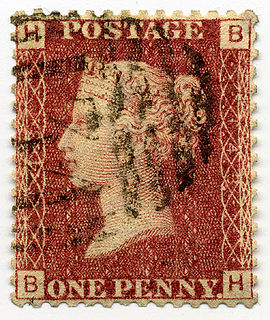
Philately is the study of postage stamps and postal history. It also refers to the collection, appreciation and research activities on stamps and other philatelic products. Philately involves more than just stamp collecting or the study of postage; it is possible to be a philatelist without owning any stamps. For instance, the stamps being studied may be very rare or reside only in museums.
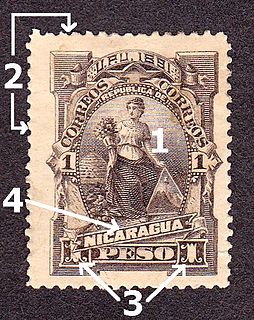
A postage stamp is a small piece of paper issued by a post office, postal administration, or other authorized vendors to customers who pay postage, who then affix the stamp to the face or address-side of any item of mail—an envelope or other postal cover —that they wish to send. The item is then processed by the postal system, where a postmark or cancellation mark—in modern usage indicating date and point of origin of mailing—is applied to the stamp and its left and right sides to prevent its reuse. The item is then delivered to its addressee.
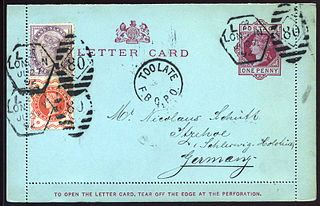
A piece of postal stationery is a stationery item, such as a stamped envelope, letter sheet, postal card, lettercard, aerogram or wrapper, with an imprinted stamp or inscription indicating that a specific rate of postage or related service has been prepaid. It does not, however, include any postcard without a pre-printed stamp.

Postal history is the study of postal systems and how they operate and, or, the study of the use of postage stamps and covers and associated postal artifacts illustrating historical episodes in the development of postal systems. The term is attributed to Robson Lowe, a professional philatelist, stamp dealer and stamp auctioneer, who made the first organised study of the subject in the 1930s and described philatelists as "students of science", but postal historians as "students of humanity". More precisely, philatelists describe postal history as the study of rates, routes, markings, and means.
This is a list of philatelic topics.

Airmail is a mail transport service branded and sold on the basis of at least one leg of its journey being by air. Airmail items typically arrive more quickly than surface mail, and usually cost more to send. Airmail may be the only option for sending mail to some destinations, such as overseas, if the mail cannot wait the time it would take to arrive by ship, sometimes weeks. The Universal Postal Union adopted comprehensive rules for airmail at its 1929 Postal Union Congress in London. Since the official language of the Universal Postal Union is French, airmail items worldwide are often marked Par avion, literally: "by airplane".

An airmail stamp is a postage stamp intended to pay either an airmail fee that is charged in addition to the surface rate, or the full airmail rate, for an item of mail to be transported by air.

A crash cover is a philatelic term for a type of cover, meaning an envelope or package that has been recovered from a fixed-wing aircraft, airship or aeroplane crash, train wreck, shipwreck or other accident. Crash covers are a type of interrupted mail.

A revenue stamp, tax stamp, duty stamp or fiscal stamp is a (usually) adhesive label used to collect taxes or fees on documents, tobacco, alcoholic drinks, drugs and medicines, playing cards, hunting licenses, firearm registration, and many other things. Typically, businesses purchase the stamps from the government, and attach them to taxed items as part of putting the items on sale, or in the case of documents, as part of filling out the form.

Astrophilately is a branch of philately which deals with the collection of stamps and postmarked envelopes related to spaceflight. It is the intersection of space and postal history. Covers cancelled on the date and at a post office near the controlling agency are used in postal exhibits to share the development and conquest of the cosmos.
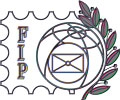
The Fédération Internationale de Philatélie (FIP) was founded on 18 June 1926, and is the world federation for philately based in Zürich, Switzerland.

Airmails of the United States or U.S. Air Mail was a service class of the United States Post Office Department and its successor United States Postal Service delivering mail flown by aircraft within the United States and its possessions and territories. Letters and parcels intended for air mail service were marked as "Via Air Mail", appropriately franked, and assigned to any then existing class or sub-class of the Air Mail service.
William Hubert Miller Jr., of New York City, was an aerophilatelist who published philatelic literature on the subject.
The American Air Mail Society (AAMS) is a U.S. nonprofit organization devoted to the collecting and study of airmail and aerophilately.
Lloyd B. Gatchell of New York City, was a philatelist who was named to the Hall of Fame of the American Philatelic Society. He was known as “Bart” to his philatelic friends and acquaintances.

A philatelic exhibition is an exhibition of stamps and postal history where stamp collectors (philatelists) compete for medals. The displays are shown in glass frames, and the exhibition is normally accompanied by stamp dealer bourses and post office stands where stamps and other philatelic items may be purchased.
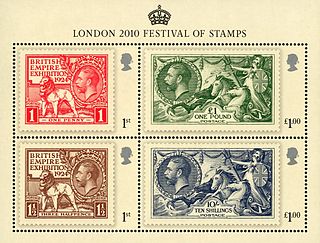
The London 2010 International Stamp Exhibition, 8–15 May 2010 at the Business Design Centre in Islington, London, was a major international stamp exhibition that was granted FIP patronage.

This is a survey of the postage stamps and postal history of Newfoundland.
The Stockholmia 2019 Internationell Frimärksutställning was an international stamp exhibition held from 29 May–2 June 2019 at the Waterfront Congress Centre in Stockholm, Sweden. It was held to celebrate the 150th anniversary of the Royal Philatelic Society London. The exhibition was granted patronage from the Fédération Internationale de Philatélie (FIP).















